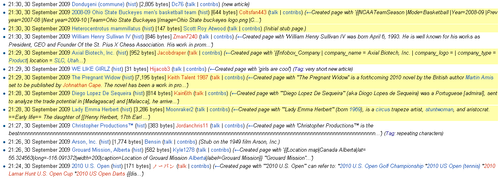User:AJZ/Патрулирование
{{Lang-Patrol}} {{Guideline (en)}} [[:Template:Nutshell|{{
- Marking an edit as patrolled is the act of verifying that an edit is in coherence with Commons guidelines.
- Unpatrolled newly created pages are marked with yellow; unpatrolled edits are indicated by an exclamation mark.
- Users who aren't patrollers don't see the indications.}}]]


Права патрулирующего - это особые права пользователя, которые позволяют помечать новые страницы и отдельные правки как патрулированные. Используется для уменьшения очереди непроверенных новых страниц и непатрулированных правок. Существует, для того чтобы сообщить другим патрулирующим, что проверенное не вандализм и не выходит за рамки проекта (или то, что нарушения были отменены/удалены).
Участники с правами патрулирующего увидят ссылку вида "[Mark as patrolled]" в нижнем правом углу любой новой страницы, и справа от diff-view, любой непатрулированной правки. Непатрулированные страницы будут выделены жёлтым on Special:NewPages. Unpatrolled edits stand out by their ! exclamation mark in front of the line. Patrollers are supposed to check in order to see if they fall within our project scope. Acceptable pages should be patrolled, and non-acceptable should either be rearranged or deleted if not possible. The right is given by default to any administrator, but can be given to trustworthy users upon request. It's possible to either ask a specific administrator for the user right or to formally request the right at Commons:Requests for rights.
How does NewPage-patrol work ?[edit]

Any page highlighted in yellow on Special:Newpages has not yet been marked as patrolled. This means that it may not have been reviewed. When you check the page, you should mark it as patrolled if (a) you see that it is a good page or (b) before or after you tag it for deletion. If you are not sure about what to do with a page, do not mark it as patrolled; another editor will review it later.
To mark a page as patrolled, simply click the "[Mark this page as patrolled]" link in the bottom right corner of the page.
What to mark as patrolled[edit]
- Anything that is appropriate for Commons.
What not to mark as patrolled[edit]
- Pages you are not sure about and no one else supports keeping (other than the author/uploader).
How does edit patrol work ?[edit]

From the Recent changes click the (diff)-link of any unpatrolled edit. Then in the diff-view review the edit by clicking the "[Mark as patrolled]" on the righthand side. After marking the edit as patrolled you can close the page, or (in the event of vandalism or other wise contributions not in coherence with Commons guidelines) perform an undo or rollback.
In the diff-view one can tell whether or not a talk-page exists by the color of the link. Let the user know you reverted his/her edit by leaving a message. See also Commons:Counter Vandalism Unit#File.
Autopatrolled[edit]
The Autopatrolled user right is similar to the patroller right in that it is a specific user right which involves marking an action as patrolled. The only difference is that autopatrollers do not have the ability to mark actions as patrolled, instead only their own actions are automatically marked as patrolled. This right is commonly granted to users who do not participate in patrolling pages, edits or uploads; but create a high level of quality pages or uploads that do not require being patrolled by other users. This reduces the backlog of Newpage, Commons:Anonymous edits and Commons:Recent uploads patrol. This right is also granted to users that make a large amount of good edits, that do not need to be patrolled, to reduce the clutter on Watchlists. Users with the patrol user right should not be granted this right, as they already have it and is redundant.
For a list of users with autopatroller, see Special:Listusers/autopatrolled
Other notes[edit]
- A log of all patrols can be seen at Special:Log/patrol. It includes usernames, articles, and the revision reviewed, and may be sorted by username or by article title.
- Pages created and modified by administrators, bots, and users with Autopatrolled are automatically marked as "patrolled (automatic)".
- There is a "Hide patrolled edits" option on Special:Newpages so that you can ignore pages that have already been reviewed.
- Even when the last few hours or even days have all been patrolled, there is still a big backlog. Pages expire from the unpatrolled queue after 720 hours (30 days).
CSS classes[edit]
There are two CSS classes related to patrolled edits:
- The class for non-patrolled articles in NewPages is
.not-patrolled, so colorblind users or users who prefer a different style can, for example, add.not-patrolled { border: 2px solid black }to their user CSS files. - The class for the exclamation mark is <coee>.unpatrolled, for example
.unpatrolled { display:none }hides them fron the RecentChanges and your Watchlist. - The class for the "Mark this page as patrolled" link in the lower-right corner of each new page is
.patrollink, you can style it in your user CSS file, for example:.patrollink { font: bold small sans-serif}
See also[edit]
- Commons:Rollback - a similar user right to fight vandalism
- Special:Log/patrol - a log of any patrol
- Commons:Counter Vandalism Unit - more information on countervandalism and tools to make that easier
{{Commons policies and guidelines}}
en:Wikipedia:New pages patrol/patrolled pages es:Wikipedia:Verificador